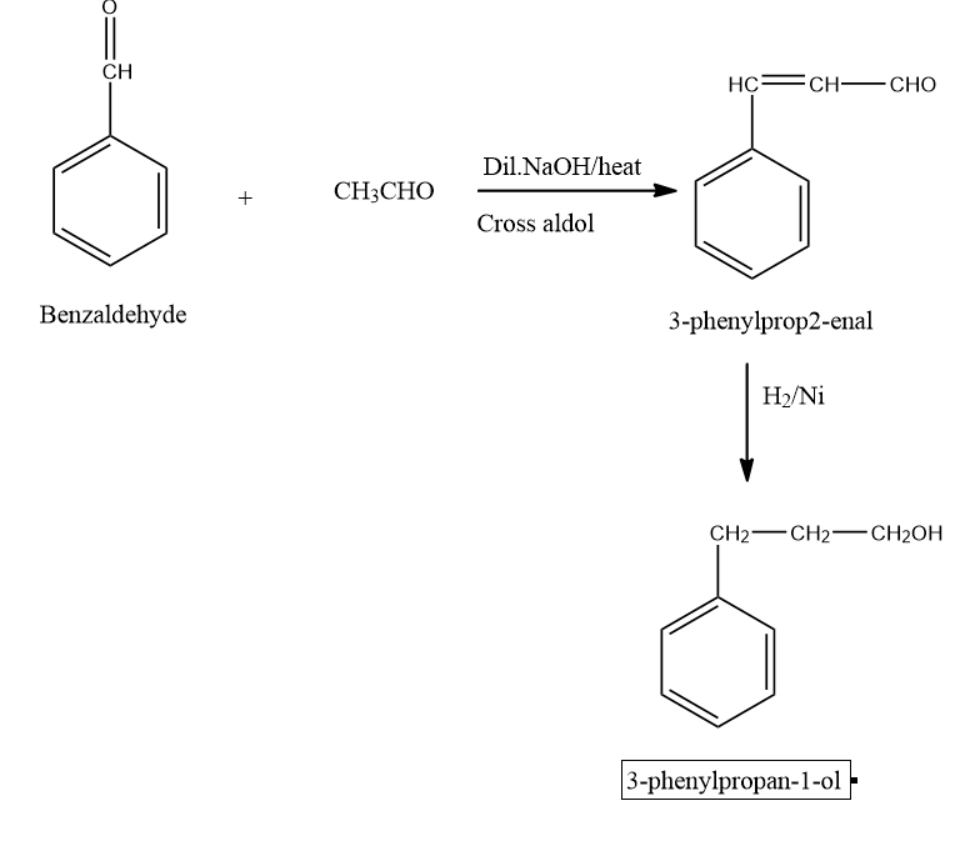
Convert Benzaldehyde to 3-Phenyl propan1-ol.
Answer
491.7k+ views
Hint: Think about the reactions of aldehydes and ketones. We need to reduce benzaldehyde and increase the carbon chain length attached to the benzene ring. The reaction does not require many steps. A few steps are enough.
Complete answer:
We know that the benzaldehyde benzene ring is attached to the aldehyde group. As benzaldehyde contains aldehyde group it shows all properties and reactions that aldehyde group shows. We first need to reduce the aldehyde group and then increase the length of the carbon chain.
We can reduce and increase the length of the carbon chain in a single step by cross aldol condensation. An aldol condensation we heat aldehydes or ketones in presence of basic medium. Alpha hydrogen-containing aldehydes or ketones lose alpha hydrogen and negative ions are formed. This negative ion attacks other aldehyde or keto groups and reduces it. As we supply heat-formed compounds will condense and a water molecule will be lost forming a double bond at reduced aldehyde group.
Cross aldol condensation will yield the desired product when one aldehyde or ketone contains alpha hydrogens and other aldehyde or ketone does not contain alpha hydrogens.
In the above conversion, acetaldehyde was made to react with benzaldehyde under cross aldol condensation. After cross aldol condensation we get 3-phenyl prop-2-enal. Reducing this aldehyde to alcohol we get the desired product.

Note: In cross aldol condensation there may be condensation between 2 acetaldehyde molecules but there will not be any aldol condensation between 2 benzaldehyde molecules because benzaldehyde does not contain alpha hydrogens. In cross aldol condensation cross condensed products will be formed in large quantities.
Complete answer:
We know that the benzaldehyde benzene ring is attached to the aldehyde group. As benzaldehyde contains aldehyde group it shows all properties and reactions that aldehyde group shows. We first need to reduce the aldehyde group and then increase the length of the carbon chain.
We can reduce and increase the length of the carbon chain in a single step by cross aldol condensation. An aldol condensation we heat aldehydes or ketones in presence of basic medium. Alpha hydrogen-containing aldehydes or ketones lose alpha hydrogen and negative ions are formed. This negative ion attacks other aldehyde or keto groups and reduces it. As we supply heat-formed compounds will condense and a water molecule will be lost forming a double bond at reduced aldehyde group.
Cross aldol condensation will yield the desired product when one aldehyde or ketone contains alpha hydrogens and other aldehyde or ketone does not contain alpha hydrogens.
In the above conversion, acetaldehyde was made to react with benzaldehyde under cross aldol condensation. After cross aldol condensation we get 3-phenyl prop-2-enal. Reducing this aldehyde to alcohol we get the desired product.

Note: In cross aldol condensation there may be condensation between 2 acetaldehyde molecules but there will not be any aldol condensation between 2 benzaldehyde molecules because benzaldehyde does not contain alpha hydrogens. In cross aldol condensation cross condensed products will be formed in large quantities.
Recently Updated Pages
Master Class 12 Economics: Engaging Questions & Answers for Success

Master Class 12 Maths: Engaging Questions & Answers for Success

Master Class 12 Biology: Engaging Questions & Answers for Success

Master Class 12 Physics: Engaging Questions & Answers for Success

Master Class 12 Business Studies: Engaging Questions & Answers for Success

Master Class 12 English: Engaging Questions & Answers for Success

Trending doubts
Give simple chemical tests to distinguish between the class 12 chemistry CBSE

How was the Civil Disobedience Movement different from class 12 social science CBSE

India is the secondlargest producer of AJute Bcotton class 12 biology CBSE

Define peptide linkage class 12 chemistry CBSE

How is democracy better than other forms of government class 12 social science CBSE

Draw a labelled sketch of the human eye class 12 physics CBSE




